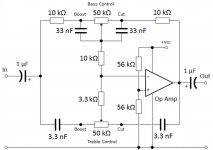Hi masters i need a powerful bass treble circuit diagram with transistor and single supply. Thanks in advance
Any Baxandall (ans its derivatives) will perform OK, although an opamp will do a better job there.
What you are looking for is called a Baxandall tone control. Like this one. Note: The 56k/56k divider needs a parallel capacitor added to the lower resistor, like this one has - 2.2-10 µF would be a good start. Otherwise power supply rejection will be poor.
Note that a circuit like this should be driven from a low-impedance source. It is probably best operated at line level if you have the necessary voltage headroom, but can also be used after a +14..+20 dB flat preamp stage following the volume control if need be.
BTW, this should be in Analog Line Level.
Note that a circuit like this should be driven from a low-impedance source. It is probably best operated at line level if you have the necessary voltage headroom, but can also be used after a +14..+20 dB flat preamp stage following the volume control if need be.
BTW, this should be in Analog Line Level.
Last edited:
You can look at early Pioneer designs that use a single supply, such as the QX-9900, assemblies AWG-013 for the single transistor amplifier and AWG-013 for the tone controlled feedback network. hifiengine has the schematicsHi masters i need a powerful bass treble circuit diagram with transistor and single supply. Thanks in advance
Can I Use Jrc4558d Instead OfUse an op amp. A single transistor has not got enough gain.
Here is a single supply op amp schematic that works with a TL071 and from 9volts up to 30 volts on a single supply rail.
12volts is ideal.
Tl071?? Thanks In Advance

Last edited:
Quite an old thread is this one.
Yes you can but remember the TL071 is a single opamp and the 4558 a dual.
Yes you can but remember the TL071 is a single opamp and the 4558 a dual.
Use an op amp. A single transistor has not got enough gain.
Here is a single supply op amp schematic that works with a TL071 and from 9volts up to 30 volts on a single supply rail.
12volts is ideal.
Bypass the lower 56k resistor with 1 to 10 uF, and stick a 10k resistor between that node and the + input. A LOT less noise from the power supply. Even a battery is too noisy not to do this. Not doing this is why single supply applications for op-amp circuits get a bad rep.
Pretty much any op amp will *work*, although the LM358/324 shouldn’t be used without hanging a 2.2k resistor from the output to ground, INSIDE the blocking cap to force a class A bias. The penalty is a few mA of supply current. That particular mod also helps many other op amp’s sound better, too - especially when the output is capacitor coupled.
If you use a bipolar opamp you'll need to add extra blocking cap(s) to avoid scratchy pots - a JFET or CMOS opamp avoids this problem by having ultra-tiny bias currents. The large bias currents of a bipolar opamp will turn even the slightest imperfection in the track-wiper contact to loud and horrible noises unless a DC blocking cap is used for the wiper connection.
On the subject of the LM358 note it doesn't have the full-power bandwidth for audio, so may clip before a proper audio opamp. Its also _shockingly_ distorting when not kept in class A (way way worse than any other opamp).
I'd suggest going for a modern, FET-input, opamp designed expressly for audio, or failing that a TL071/2/4 which was the JFET opamp of choice way back when.
On the subject of the LM358 note it doesn't have the full-power bandwidth for audio, so may clip before a proper audio opamp. Its also _shockingly_ distorting when not kept in class A (way way worse than any other opamp).
I'd suggest going for a modern, FET-input, opamp designed expressly for audio, or failing that a TL071/2/4 which was the JFET opamp of choice way back when.
- Home
- Source & Line
- Analog Line Level
- Bass treble circuit

 Moved to analog line level
Moved to analog line level